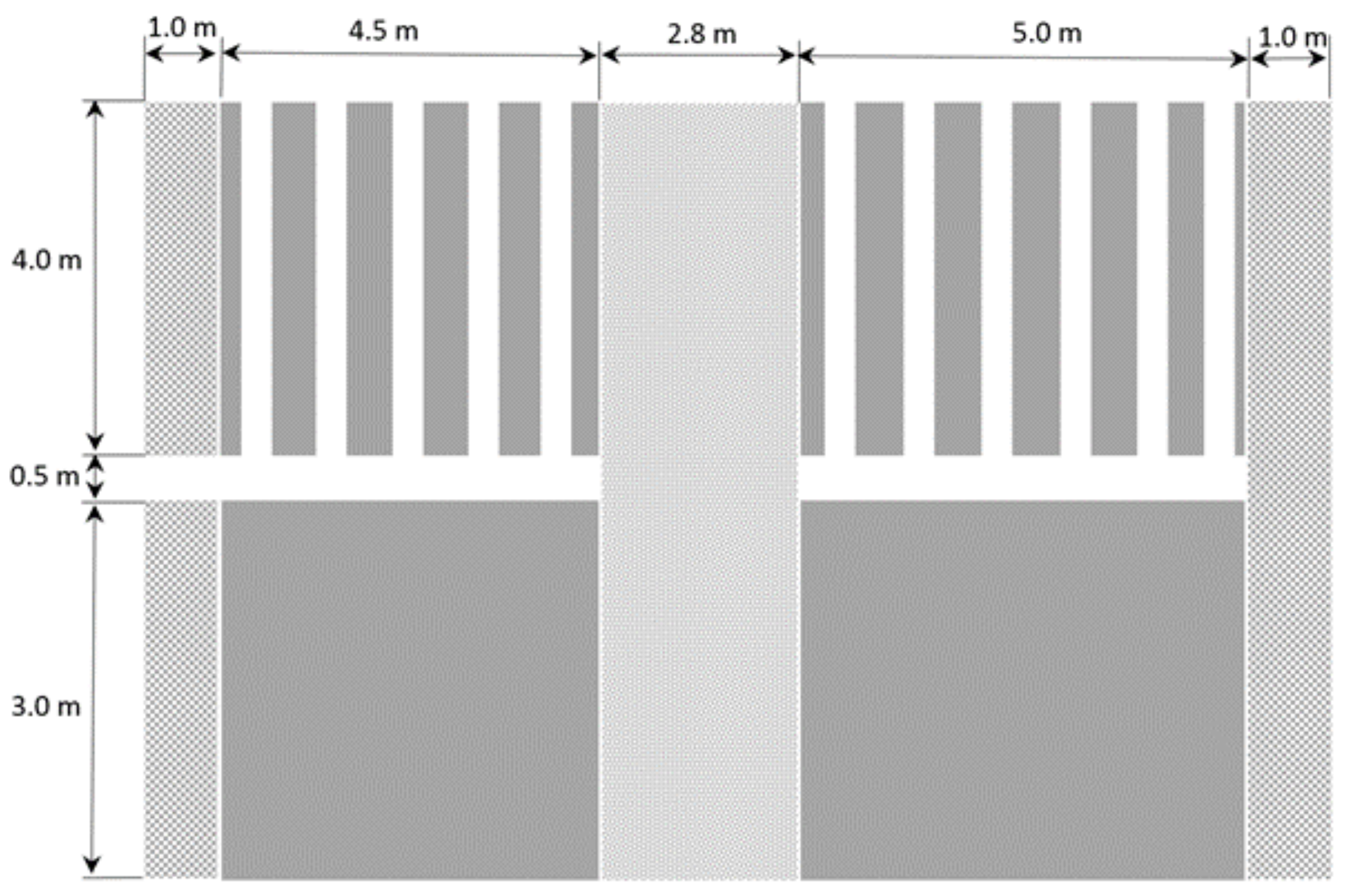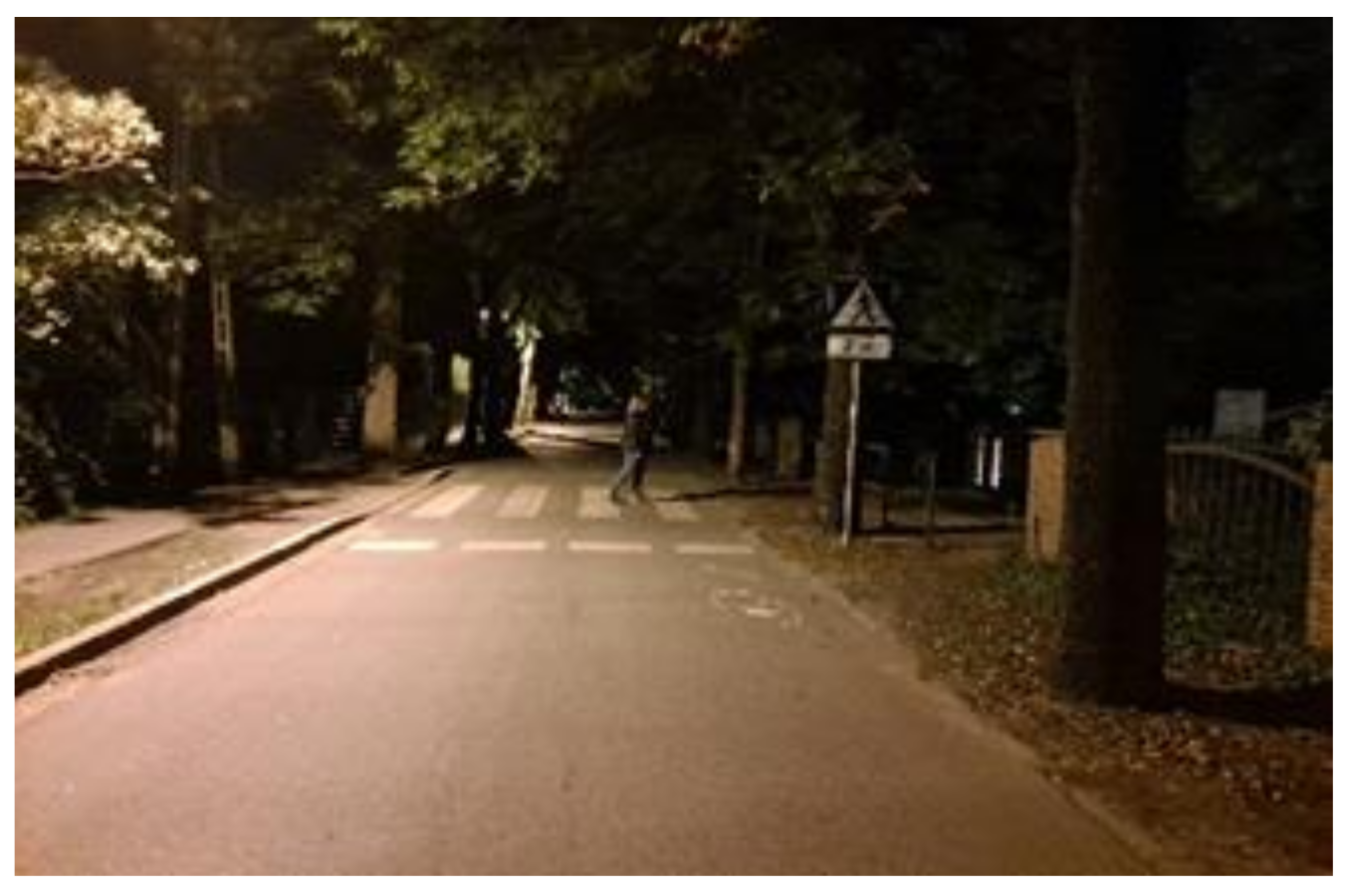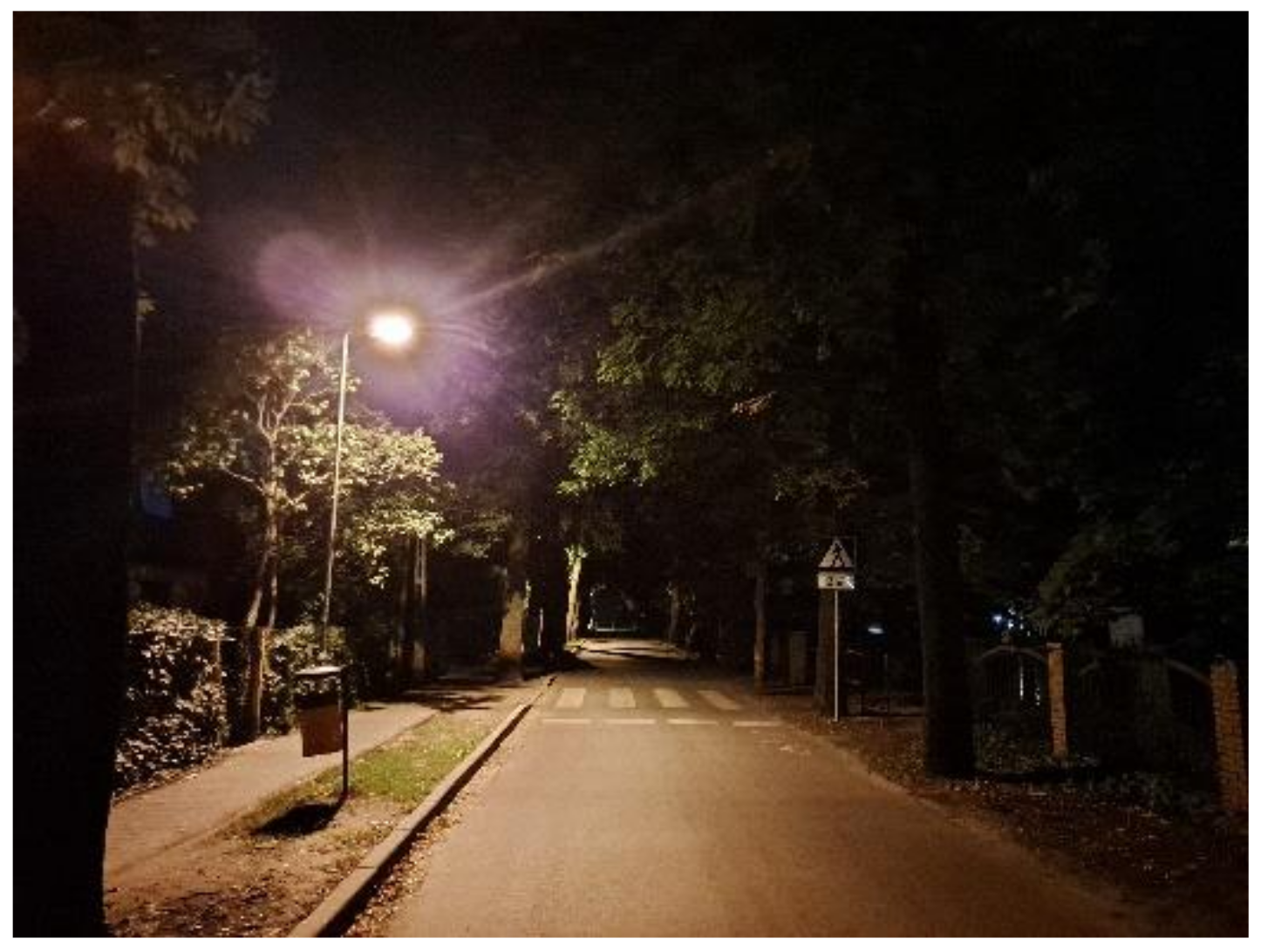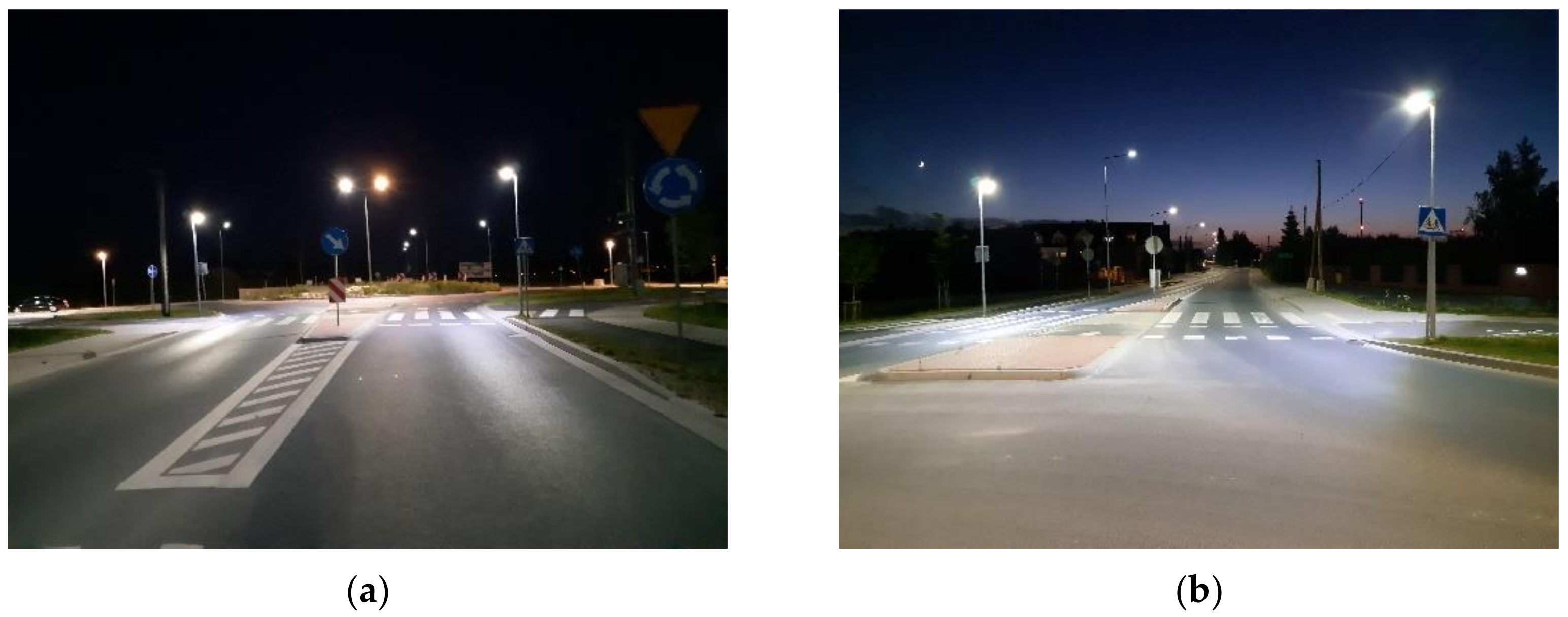On the Quality of Street Lighting in Pedestrian Crossings
Abstract
:1. Introduction
2. Lighting Requirements at Pedestrian Crossings
3. Aim and Scope of the Study
4. Materials and Method
5. Estimation of Measurement Uncertainty
6. Measurements of Illuminance at the Analyzed Pedestrian Crossings
7. Evaluation of Illumination Quality and Measurement Procedures at the Pedestrian Crossings under Analysis
7.1. Evaluation of Lighting Parameters at the Pedestrian Crossings
7.2. Evaluation of the Measurement Procedures
8. Measurements and Assessment of Luminance Contrast at the Analyzed Pedestrian Crossings
8.1. Measurements of Luminance Contrast
8.2. Assessment of the Results Obtained
9. Conclusions
10. Limitations
Author Contributions
Funding
Institutional Review Board Statement
Informed Consent Statement
Data Availability Statement
Conflicts of Interest
Appendix A



Appendix B
| Vertical Illuminance Ev [lx] Measurement According to Polish Recommendation | |||||||
| Measurement height | Measurement points along the crossing | ||||||
| Y1 | Y2 | Y3 | Y4 | Y5 | Y6 | ||
| centre line of the crossing | 1.5 m | 37 | 31 | 17 | 10 | 5 | 4 |
| 1.0 m | 37 | 31 | 18 | 9 | 4 | 3 | |
| 0.5 m | 35 | 30 | 16 | 9 | 2 | 2 | |
| Measurement according to Czech recommendation | |||||||
| Waiting area | Road | Waiting area | |||||
| data measurement points across the crossing | X1 | 27 | 23 | 13 | 6 | 3 | |
| X2 | 37 | 30 | 13 | 5 | 4 | ||
| X3 | 40 | 33 | 12 | 6 | 2 | ||
| Vertical Illuminance Ev [lx] Measurement According to Polish Recommendation | |||||||||||
| Measurement height | Measurement points along the crossing | ||||||||||
| Y1 | Y2 | Y3 | Y4 | Y5 | Y6 | Y7 | Y8 | Y9 | Y10 | ||
| centre line of the crossing | 1.5 m | 114 | 141 | 161 | 169 | 171 | 180 | 183 | 201 | 102 | 98 |
| 1.0 m | 87 | 122 | 138 | 140 | 149 | 157 | 162 | 179 | 161 | 93 | |
| 0.5 m | 74 | 101 | 114 | 122 | 128 | 134 | 145 | 158 | 139 | 86 | |
| Measurement according to Czech recommendation | |||||||||||
| Waiting area | Road | Waiting area | |||||||||
| data measurement points across the crossing | X1 | 78 | 86 | 88 | 83 | 101 | 112 | 84 | 101 | ||
| X2 | 108 | 128 | 144 | 150 | 170 | 191 | 169 | 92 | |||
| X3 | 106 | 125 | 136 | 137 | 130 | 127 | 131 | 81 | |||
| Vertical Illuminance Ev [lx] Measurement According to Polish Recommendation | |||||||||||
| Measurement height | Measurement points along the crossing | ||||||||||
| Y1 | Y2 | Y3 | Y4 | Y5 | Y6 | Y7 | Y8 | Y9 | Y10 | ||
| centre line of the crossing | 1.5 m | 94 | 105 | 127 | 138 | 146 | 153 | 166 | 177 | 158 | 109 |
| 1.0 m | 80 | 89 | 99 | 120 | 121 | 139 | 151 | 163 | 143 | 88 | |
| 0.5 m | 60 | 67 | 84 | 90 | 93 | 114 | 127 | 121 | 114 | 60 | |
| Measurement according to Czech recommendation | |||||||||||
| Waiting area | Road | Waiting area | |||||||||
| Y1 | Y2 | Y3 | Y4 | Y5 | Y6 | Y7 | Y8 | ||||
| data measurement points across the crossing | X1 | 58 | 63 | 67 | 80 | 86 | 94 | 86 | 72 | ||
| X2 | 81 | 99 | 114 | 124 | 149 | 161 | 144 | 99 | |||
| X3 | 77 | 81 | 90 | 105 | 126 | 134 | 120 | 93 | |||
| Vertical Illuminance Ev [lx] Measurement According to Polish Recommendation | |||||||||
| Measurement height | Measurement points along the bike path | ||||||||
| Y1 | Y2 | Y3 | Y4 | Y5 | Y6 | ||||
| centre line of the crossing | 1.5 m | 21 | 43 | 57 | 67 | 63 | 49 | ||
| 1.0 m | 19 | 39 | 52 | 59 | 54 | 45 | |||
| 0.5 m | 18 | 32 | 49 | 53 | 47 | 39 | |||
| Measurement points along the crossing | |||||||||
| 1.5 m | 23 | 39 | 54 | 76 | 95 | 75 | |||
| 1.0 m | 22 | 35 | 51 | 66 | 74 | 58 | |||
| 0.5 m | 20 | 32 | 49 | 52 | 61 | 47 | |||
| Measurement according to Czech recommendation | |||||||||
| data measurement points across the crossing | Measurement points along the bike path | ||||||||
| Waiting area | Road | Waiting area | |||||||
| Y1 | Y2 | Y3 | Y4 | Y5 | Y6 | Y7 | |||
| X1 | 16 | 24 | 29 | 39 | 37 | 35 | 30 | ||
| X2 | 18 | 31 | 35 | 49 | 57 | 52 | 42 | ||
| X3 | 26 | 42 | 42 | 63 | 76 | 63 | 54 | ||
| Measurement points along the crossing | |||||||||
| X1 | 26 | 38 | 44 | 67 | 80 | 69 | 59 | ||
| X2 | 20 | 32 | 36 | 47 | 61 | 58 | 50 | ||
| X3 | 16 | 24 | 28 | 36 | 42 | 49 | 35 | ||
| Vertical Illuminance Ev [lx] Measurement According to Polish Recommendation | |||||||||
| Measurement height | Measurement points along the bike path | ||||||||
| Y1 | Y2 | Y3 | Y4 | Y5 | Y6 | ||||
| centre line of the crossing | 1.5 m | 83 | 80 | 51 | 38 | 28 | 18 | ||
| 1.0 m | 78 | 62 | 46 | 32 | 25 | 16 | |||
| 0.5 m | 62 | 50 | 42 | 34 | 21 | 15 | |||
| Measurement points along the crossing | |||||||||
| 1.5 m | 89 | 86 | 67 | 47 | 32 | 21 | |||
| 1.0 m | 85 | 82 | 58 | 41 | 25 | 19 | |||
| 0.5 m | 78 | 71 | 56 | 33 | 24 | 18 | |||
| Measurement according to Czech recommendation | |||||||||
| data measurement points across the crossing | Measurement points along the bike path | ||||||||
| Waiting area | Road | Waiting area | |||||||
| Y1 | Y2 | Y3 | Y4 | Y5 | Y6 | Y7 | |||
| X1 | 57 | 49 | 35 | 28 | 23 | 18 | 13 | ||
| X2 | 79 | 68 | 45 | 35 | 25 | 19 | 16 | ||
| X3 | 90 | 82 | 58 | 40 | 26 | 19 | 18 | ||
| Measurement points along the crossing | |||||||||
| X1 | 95 | 88 | 64 | 42 | 28 | 23 | 20 | ||
| X2 | 84 | 75 | 58 | 37 | 26 | 20 | 18 | ||
| X3 | 64 | 59 | 47 | 31 | 24 | 18 | 16 | ||
| Conflict Area | Direction of Measurement | Object Luminance (Board) Lo [cd/m2] | Background Luminance (Left Side) Lb1 [cd/m2] | Background Luminance (Right Side) Lb2 [cd/m2] | Average Background Luminance Lb [cd/m2] | Contrast C [-] |
|---|---|---|---|---|---|---|
| pedestrian crossing no 1 | allowed on a one-way road | 1.75 | 0.19 | 0.51 | 0.35 | 4.0 |
| 0.70 | 0.40 | 0.19 | 0.30 | 1.4 | ||
| 0.27 | 0.15 | 0.02 | 0.09 | 2.2 | ||
| pedestrian crossing no 2 | A | 5.03 | 0.97 | 1.09 | 1.03 | 3.9 |
| 5.11 | 3.42 | 1.67 | 2.55 | 1.0 | ||
| 5.67 | 1.4 | 0.72 | 1.06 | 4.4 | ||
| 7.18 | 1.56 | 0.87 | 1.22 | 4.9 | ||
| 5.14 | 0.67 | 0.62 | 0.50 | 7.0 | ||
| B | 3.45 | 0.62 | 0.73 | 0.68 | 4.1 | |
| 3.60 | 0.98 | 2.62 | 1.80 | 1.0 | ||
| 4.68 | 2.31 | 1.05 | 1.68 | 1.8 | ||
| 4,30 | 0.78 | 0.44 | 0.61 | 6.0 | ||
| 2.90 | 0.27 | 0.50 | 0.39 | 6.5 | ||
| pedestrian crossing no 3 | C | 2.97 | 0.92 | 0.67 | 0.80 | 2.7 |
| 2.06 | 0.84 | 0.88 | 0.86 | 1.4 | ||
| 1.72 | 1.17 | 0.9 | 1.04 | 0.7 | ||
| D | 4.50 | 0.11 | 0.30 | 0.21 | 20.9 | |
| 3.15 | 0.13 | 0.14 | 0.14 | 22.3 | ||
| 1.99 | 0.09 | 0.28 | 0.19 | 9.8 | ||
| bike path | C | 2.64 | 0.63 | 0.56 | 0.60 | 3.4 |
| 2.32 | 0.83 | 0.76 | 0.80 | 1.9 | ||
| 2.06 | 0.97 | 0.81 | 0.89 | 1.3 | ||
| D | 2.99 | 0.11 | 0.10 | 0.11 | 27.5 | |
| 2.22 | 0.11 | 0.10 | 0.11 | 20.1 | ||
| 1.90 | 0.20 | 0.25 | 0.23 | 7.4 |
References
- Available online: https://ec.europa.eu/transport/road_safety/sites/default/files/pdf/statistics/dacota/asr2018.pdf (accessed on 29 September 2021).
- Available online: https://ec.europa.eu/transport/road_safety/sites/default/files/pdf/statistics/dacota/bfs20xx_pedestrians.pdf (accessed on 29 September 2021).
- Report of the Supreme Chamber of Control. Poland: Safety of Road Traffic Participants; No 125/2021.megainfo/KPB; Department of Public Order and Internal Security, Supreme Audit Office: Warsaw, Poland, 2021. (In Polish)
- Available online: https://www.senat.gov.pl/gfx/senat/pl/senatekspertyzy/5482/plik/oe_288.pdf (accessed on 29 September 2021).
- Freedman, M.; Janoff, M.S.; Koth, B.W.; McCunney, W. Fixed Illumination for Pedestrian Protection: User’s Manual; FHWA-RD-76-9; Federal Highway Administration: Washington, DC, USA, 1975.
- Hasson, P.; Lutkevich, P.; Ananthanarayanan, B.; Watson, P.; Knoblauch, R.; Nitzburg, M. Field test for lighting to improve safety at pedestrian crosswalks. In Proceedings of the 16th Biennial Symposium on Visibility and Simulation, University of Iowa, Iowa City, IA, USA, 2–4 June 2002. [Google Scholar]
- Gibbons, R.B.; Hankey, J.M. Influence of Vertical Illuminance on Pedestrian Visibility in Crosswalks. Transp. Res. Rec. J. Transp. Res. Board. 2006, 1973, 105–112. [Google Scholar] [CrossRef]
- Edwards, C.J.; Gibbons, R.B. The relationship of vertical illuminance to pedestrian visibility in crosswalks. Transp. Res. Rec. J. Transp. Res. 2008, 2056, 9–16. [Google Scholar] [CrossRef]
- Peña-García, A.; Hurtado, A.; Aguilar-Luzón, M. Impact of public lighting on pedestrians’ perception of safety and well-being. Saf. Sci. 2015, 78, 142–148. [Google Scholar] [CrossRef]
- Markvica, K.; Richter, G.; Lenz, G. Impact of urban street lighting on road users’ perception of public space and mobility behavior. Build. Environ. 2019, 154, 32–43. [Google Scholar] [CrossRef]
- Davidovic, M.; Djokic, L.; Cabarkapa, A.; Djuretic, A.; Skerovic, V.; Kostic, M. Drivers’ Preference for the Color of LED Street Lighting. IEEE Access 2019, 7, 72850–72861. [Google Scholar] [CrossRef]
- Patella, S.M.; Sportiello, S.; Carrese, S.; Bella, F.; Asdrubali, F. The effect of a LED lighting crosswalk on pedestrian safety: Sam experimental results. Safety 2020, 6, 20. [Google Scholar] [CrossRef] [Green Version]
- Saraiji, R. Vertical Illuminance Based Crosswalk Illumination. LEUKOS 2009, 6, 153–167. [Google Scholar] [CrossRef]
- Baleja, R.; Bos, P.; Novak, T.; Sokansky, K.; Hanusek, T. Increasing of visibility on pedestrian crossing by the additional lighting system. In Proceedings of the IOP Conference Series: Materials Science and Engineering, Prague, Czech Republic, 21–22 September 2017; Volume 236. [Google Scholar] [CrossRef] [Green Version]
- Blaha, Z.; Novak, T.; Sokansky, K. Conflict areas on roads which are illuminated by public lighting. Electr. Rev. 2013, 89, 31–34. [Google Scholar]
- Tomczuk, P. Assessment model of luminance contrast of pedestrian figure against background on pedestrian crossing. Electr. Rev. 2012, 88, 104–107. [Google Scholar]
- Tomczuk, P.; Chrzanowicz, M.; Mackun, T.; Budzynski, M. Analysis of the results of the audit of lighting parameters at pedestrian crossings in Warsaw. Arch. Transp. 2021, 59, 21–39. [Google Scholar] [CrossRef]
- Doulos, L.; Sioutis, I.; Kontaxis, P.; Zissis, G.; Faidas, K. A decision support system for assessment of street lighting tenders based on energy performance indicators and environmental criteria: Overview, methodology and case study. Sustain. Cities Soc. 2019, 51, 101759. [Google Scholar] [CrossRef]
- Rossi, G.; Iacomussi, P.; Zinzi, M. Lighting Implications of Urban Mitigation Strategies through Cool Pavements: Energy Savings and Visual Comfort. Climate 2018, 6, 26. [Google Scholar] [CrossRef] [Green Version]
- Yao, Q.; Wang, H.; Uttley, J.; Zhuang, X. Illuminance Reconstruction of Road Lighting in Urban Areas for Efficient and Healthy Lighting Performance Evaluation. Appl. Sci. 2018, 8, 1646. [Google Scholar] [CrossRef] [Green Version]
- Carli, R.; Dotoli, M. A Dynamic Programming Approach for the Decentralized Control of Energy Retrofit in Large-Scale Street Lighting Systems. IEEE Trans. Autom. Sci. Eng. 2020, 17, 1140–1157. [Google Scholar] [CrossRef]
- Bonomolo, M.; Baglivo, C.; Bianco, G.; Congedo, P.M.; Beccali, M. Cost optimal analysis of lighting retrofit scenarios in educational buildings in Italy. Energy Procedia 2017, 126, 171–178. [Google Scholar] [CrossRef]
- Available online: https://www.gov.pl/web/infrastruktura/program-bezpiecznej-infrastruktury-drogowej-na-lata-2021-2024 (accessed on 29 September 2021).
- EN 13201: 2015: Road Lighting; The European Committee for Standardization: Brussels, Belgium, 2015.
- DIN 67523-1: Lighting of Pedestrian Crossings (sign 293 StVO) with Additional Lighting—Part 1: General Quality Characteristics and Guide Values; The German Institute for Standardization: Berlin, Germany, 2010. (In German)
- Ministry of Transport of the Czech Republic 2006 Technické Kvalitativní Podmínky Staveb Pozemních Komunikací, Kapitola 15, Osvětlování Pozemních Komunikací, Dodatek č. 1—Přisvětlování Přechodů; The Ministry of Transport, Department of Roads: Praha, Czech Republic, 2015. (In Czech)
- Available online: https://www.gov.pl/web/infrastruktura/wytyczne-organizacji-bezpiecznego-ruchu-pieszych-wytyczne-prawidlowego-oswietlenia-przejsc-dla-pieszych (accessed on 29 September 2021).
- CIE Publication No 19:1979: A Unified Framework of Methods for Evaluating Visual Performance Aspects of Lighting; The International Commission on Illumination: Viena, Austria, 1979.
- ISO/CIE 19476:2014: Characterization of the Performance of Illuminance Meters and Luminance Meters; The International Organization for Standardization: Geneva, Switzerland, 2014.
- Zalesinska, M.; Wandachowicz, K. Study on the quality of pedestrian crossing lighting (in Polish). In Proceedings of the XXIXth Conference on Lighting Technology (KKO2021), Warsaw, Poland, 17–18 June 2021; Polish Committee on Illumination: Warsaw, Poland, 2021. [Google Scholar]
- Adria, W. Visibility of targets: Model for calculation. Lighting Res. Technol. 1989, 21, 181–188. [Google Scholar] [CrossRef]
- Roadway Lighting. ANSI/IESNA RP-8-00: American National Standard Practice for Broadway Lighting, Approval 2000; The Illuminating Engineering Society of North America: New York, NY, USA, 2000.
- Tomczuk, P. Assessment of lighting quality of pedestrian figure on the crossing. Pr. Nauk. Politech. Warszawskiej. Transp. 2012, 87, 101–115. (In Polish) [Google Scholar]



















| Road Luminance L [cd/m2] | Road Illuminance E [lx] | Average Vertical Illuminance Ev [lx] | ||
|---|---|---|---|---|
| Road [Minimum] | Waiting Area [Minimum] | Whole Area [Maximum] | ||
| 1.5 ≤ L | 50 ≤ E | Additional illumination is not required | ||
| 1 ≤ L < 1.5 | 30 ≤ E < 50 | 75 | 50 | 200 |
| 0.75 ≤ L < 1.0 | 20 ≤ E < 30 | 50 | 30 | 150 |
| 0.5 ≤ L < 0.75 | 10 ≤ E < 20 | 30 | 20 | 100 |
| L < 0.5 | E < 10 | 15 | 10 | 50 |
| Road Luminance L [cd/m2] | Road Illuminance E [lx] | Vertical Illuminance Ev [lx] (Minimum Value) | Horizontal Illuminance Eh [lx] (Minimum Value) | |||
|---|---|---|---|---|---|---|
| Pedestrian Crossings | Edge Points | Pedestrian Crossings | ||||
| M1 | 2.00 | C0 | 50 | Additional illumination is not required | ||
| M2 | 1.50 | C1 | 30 | 75 | 5.0 | 75 |
| M3 | 1.00 | C2 | 20 | 50 | 4.0 | 50 |
| M4 | 0.75 | C3 | 15 | 50 | 4.0 | 50 |
| M5 | 0.50 | C4 | 10 | 25 | 3.0 | 25 |
| M6 | 0.30 | C5 | 7.5 | 15 | 2.0 | 15 |
| Pedestrian Crossings | Direction of Measurement | Luminance in Front of a Pedestrian Crossing L [cd/m2] | Vertical Illuminance | Horizontal Illuminance | |||
|---|---|---|---|---|---|---|---|
| Road | Edge Points | Road | |||||
| Ev [lx] | U0V [-] | Evmin [lx] | Eh [lx] | U0h [-] | |||
| pedestrian crossing no 1 | allowed on a one-way road | 0.60 | 17 | 0.06 | 1 | 11 | 0.12 |
| pedestrian crossing no 2 | A | 3.63 | 137 | 0.54 | 36 | 260 | 0.59 |
| B | 2.90 | 117 | 0.51 | 23 | |||
| pedestrian crossing no 3 | C | 0.73 | 52 | 0.39 | 7 | 63 | 0.67 |
| D | 52 | 0.35 | 5 | 49 | 0.67 | ||
| bike path | C | 0.73 | 45 | 0.40 | 8 | 76 | 0.64 |
| D | 43 | 0.35 | 7 | 43 | 0.58 | ||
| Pedestrian Crossings | Direction of Measurement | Luminance in Front of a Pedestrian Crossing L [cd/m2] | Vertical Illuminance | ||||
|---|---|---|---|---|---|---|---|
| Road | Waiting Area | Whole Area | |||||
| Ev [lx] | U0V [-] | Ev [lx] | U0h [-] | Ratio | |||
| pedestrian crossing no 1 | allowed on a one-way road | 0.60 | 16 | 0.3 | 2 | 0.7 | 8 |
| pedestrian crossing no 2 | A | 3.63 | 127 | 0.7 | 91 | 0.9 | 1.4 |
| B | 2.90 | 107 | 0.6 | 72 | 0.8 | 1.5 | |
| pedestrian crossing no 3 | C | 0.73 | 57 | 0.6 | 29 | 0.5 | 2.0 |
| D | 56 | 0.6 | 21 | 0.7 | 2.7 | ||
| bike path | C | 0.73 | 52 | 0.7 | 29 | 0.5 | 1.8 |
| D | 49 | 0.6 | 20 | 0.7 | 2.5 | ||
| Pedestrian Crossing | Direction of Measurement | Average Luminance of the Object Lo [cd/m2] | Average Luminance of the Background Lb [cd/m2] | Average Contrast C [-] |
|---|---|---|---|---|
| pedestrian crossing no 1 | allowed on a one-way road | 0.91 | 0.24 | 2.5 |
| pedestrian crossing no 2 | A | 5.63 | 1.30 | 4.2 |
| B | 3.79 | 1.03 | 3.9 | |
| pedestrian crossing no 3 | C | 2.25 | 0.90 | 1.6 |
| D | 3.21 | 0.18 | 17.7 | |
| bike path | C | 2.34 | 0.76 | 2.2 |
| D | 2.37 | 0.15 | 18.3 |
| Contrast C [-] | Luminance of the Object Lo [cd/m2] | ||||||
|---|---|---|---|---|---|---|---|
| 0.05 ≤ LT ≤ 0.5 | 0.25 ≤ LT ≤ 1 | 0.75 ≤ LT ≤ 2 | 1.5 ≤ LT ≤ 4.5 | 3 ≤ LT ≤ 10 | 6 ≤ LT ≤12 | LT > 12 | |
| −1 ≤ C ≤ −0.05 | 3 | 2 | 1 | 1 | 1 | 1 | 1 |
| −0.1 ≤ C ≤ 0.1 | 1 | 1 | 1 | 1 | 1 | 1 | 1 |
| 0.05 ≤ C ≤ 0.1 | 1 | 2 | 3 | 3 | 3 | 3 | 3 |
| 0.25 ≤ C ≤ 1.6 | 2 | 3 | 3 | 4 | 4 | 4 | 6 |
| 1 ≤ C ≤ 3 | 2 | 3 | 4 | 4 | 4 | 5 | 7 |
| 2 ≤ C ≤ 4 | 3 | 4 | 4 | 5 | 5 | 6 | 8 |
| 3 ≤ C ≤ 5 | 3 | 4 | 5 | 6 | 6 | 7 | 9 |
| C > 4 | 3 | 5 | 6 | 7 | 7 | 8 | 10 |
| Conflict Area | Direction of Measurement | Vertical Illuminance 1Ev [lx] | Average Luminance of the Object Lo [cd/m2] | Average Contrast C [-] | Scoring According with [18] | Assessment of Lighting |
|---|---|---|---|---|---|---|
| pedestrian crossing no 1 | allowed on a one-way road | 17 | 0.91 | 2.5 | 4 | medium |
| pedestrian crossing no 2 | A | 137 | 5.63 | 4.2 | 7 | better than good |
| B | 117 | 3.79 | 3.9 | 7 | ||
| pedestrian crossing no 3 | C | 45 | 2.25 | 1.6 | 5 | medium-good |
| D | 43 | 3.21 | 17.7 | 8 | very good | |
| bike path | C | 52 | 2.34 | 2.2 | 5 | medium-good |
| D | 52 | 2.37 | 18.3 | 8 | very good |
Publisher’s Note: MDPI stays neutral with regard to jurisdictional claims in published maps and institutional affiliations. |
© 2021 by the authors. Licensee MDPI, Basel, Switzerland. This article is an open access article distributed under the terms and conditions of the Creative Commons Attribution (CC BY) license (https://creativecommons.org/licenses/by/4.0/).
Share and Cite
Zalesinska, M.; Wandachowicz, K. On the Quality of Street Lighting in Pedestrian Crossings. Energies 2021, 14, 7349. https://doi.org/10.3390/en14217349
Zalesinska M, Wandachowicz K. On the Quality of Street Lighting in Pedestrian Crossings. Energies. 2021; 14(21):7349. https://doi.org/10.3390/en14217349
Chicago/Turabian StyleZalesinska, Malgorzata, and Krzysztof Wandachowicz. 2021. "On the Quality of Street Lighting in Pedestrian Crossings" Energies 14, no. 21: 7349. https://doi.org/10.3390/en14217349
APA StyleZalesinska, M., & Wandachowicz, K. (2021). On the Quality of Street Lighting in Pedestrian Crossings. Energies, 14(21), 7349. https://doi.org/10.3390/en14217349






